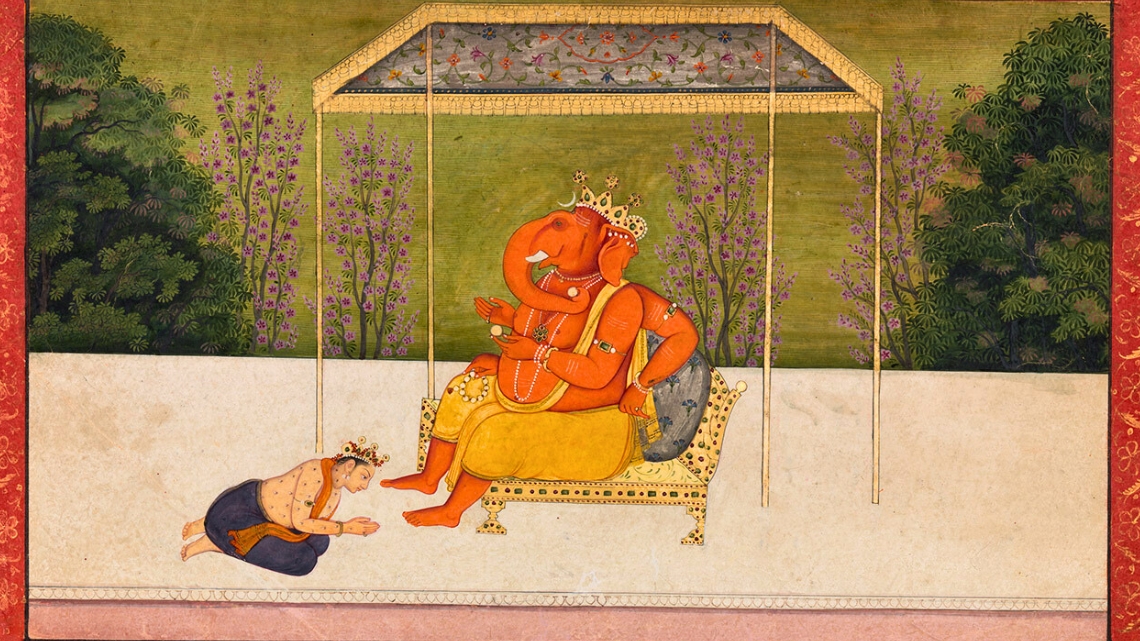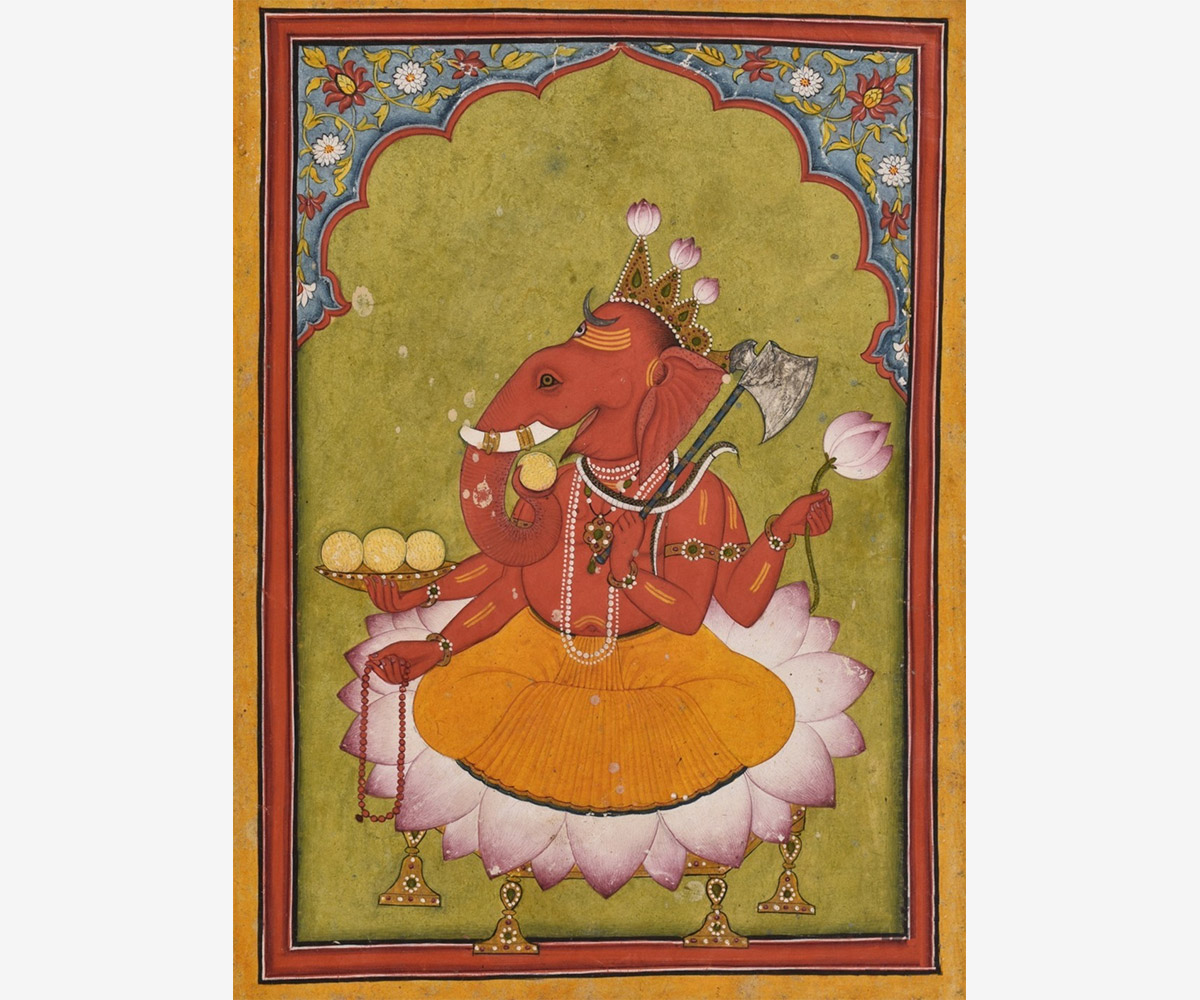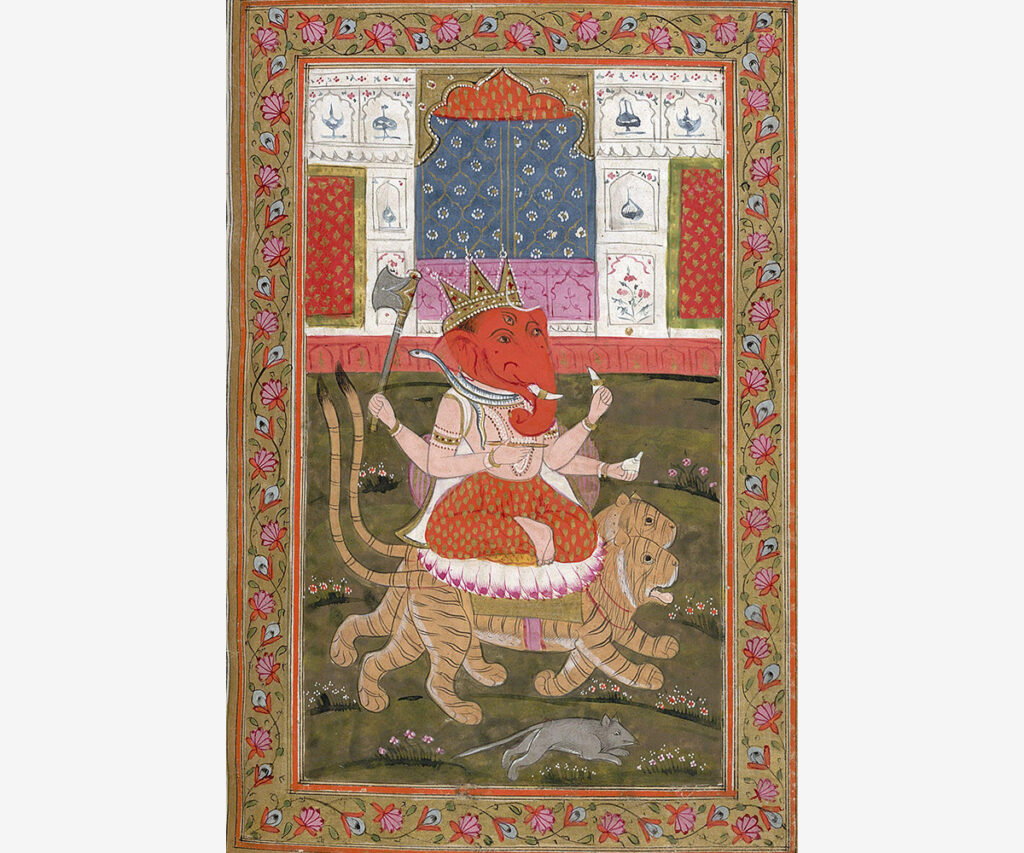The Pahari School of Paintings Depicting Lord Ganesha

It is said that “Art is not what you see, but what you make others see.”
The history of Indian art itself has a long journey from ancient to modern art. We also have several painting styles that had been developed in India. One such distinct style of painting which emerged in India was the Pahari Style Painting
The word Pahari denotes ‘hilly or mountainous’ region. Pahari Painting is an umbrella term used for a form of Indian painting, done mostly in miniature forms, originating from the Himalayan hills of North India and plains of Punjab, during the early 17th to mid-19th century. The Pahari miniature paintings, known for their delicate charm, vibrant colours, and intricate details, are one of the most remarkable art forms to emerge from the northern regions of India.
With the entry of Mughal Artists, different styles with a mixture of Indian and Mughal art styles came into picture. Pahari miniature paintings are one example of such styles. It is the mixture of three main style of Indian Art: Indian folk art, Rajasthani art and the Mughal miniature art style.

Origin of Pahari Miniature Paintings:
B. N. Goswamy, one of the most revered scholars of the Pahari Schools of Painting, has attributed the shaping of the Pahari painting to the family of Pandit Seu (Shiv)
Theme of the Pahari Miniature Paintings:
The themes typically revolve around Hindu deities, scenes from the Ramayana and Mahabharata, and the romance of Krishna and Radha. Among these religious figures, Lord Ganesha, the beloved elephant-headed god of wisdom and new beginnings, has been an enduring subject in the Pahari style. Ganesha painting depicted in various forms and postures that exude elegance and devotion is one of the well-known subjects of Pahari Painting.
Major Pahari Schools of Painting
1. The Basohli School: The Beginning of Pahari Painting
The Basohli school of painting is often regarded as the earliest and one of the most distinctive sub-schools of Pahari painting. Originating in the town of Basohli in present-day Jammu, this style developed in the late 17th century under the patronage of Raja Kirpal Pal. Known for its bold use of colours, strong lines, and exaggerated features, the Basohli school set the stage for the later development of Pahari painting.
2. The Guler School: A Shift toward Naturalism
In the mid-18th century, the Guler school of painting emerged as a softer, more refined style compared to the boldness of Basohli. The Guler school, centered around the royal court of Guler (in present-day Himachal Pradesh), was strongly influenced by the Mughal court’s naturalistic style, thanks to the patronage of Raja Dalip Singh, who invited artists from the Mughal courts to settle in his kingdom.
3. The Kangra School: The Pinnacle of Pahari Painting
The Kangra school of painting, which emerged in the late 18th century, represents the height of Pahari miniature painting. Kangra, another princely state in Himachal Pradesh, became a major center for artistic excellence under the patronage of Raja Sansar Chand. The Kangra style is often considered the most refined and sophisticated of the Pahari sub-schools.
Unique Ganesh Images in Pahari School
Ganesha is a much-revered god in Hinduism and is worshipped by millions of Hindus across India. Lord Ganapati’s iconic representations are many. He has been well depicted in all schools of miniature painting. Let us check out some unique depictions of Ganesha from the Pahari Schools of miniature painting in India.
- Ganesha Ready to Throw His Lotus in Basohli Style
One of the earliest known depictions of Ganesha in the Basohli style is characterized by its strong, bold lines and vibrant colours. In this particular painting, Ganesha is shown seated on a low pedestal, his trunk playfully curled and resting on a modak (sweet) in his hand. In his two left hands, Gaṇesha holds a large lotus above and an axe below, with its handle leaning against his shoulder. According to mythology, in order to kill the demon of egotism (Mamāsura) who had attacked him, Gaṇesha Vighnarāja throws his lotus at him. Unable to bear the fragrance of the divine flower, the demon surrenders to Gaṇesha. The background of this Ganesha miniature painting is bright yellow, a colour traditionally associated with Basohli paintings, representing the divine aura of Ganesha.
- Indra worships Ganesha
Lord Indra is associated with the sky, lightning, weather, thunder, storms, rains, river flows, and war. In this particular Ganesha miniature painting, Ganesha is seated regally on a golden, ornate throne under a canopy, while Lord Indra is seen bowing reverently before him. The image is set in a peaceful outdoor garden-like scene with blooming plants and trees, which is characteristic of the Pahari style, known for its delicate nature backgrounds. This painting captures the elegance and spiritual essence of the Pahari school of painting, blending intricate details, devotional themes, and natural elements harmoniously.
- Simha Ganesha, Basohli, 18th century
In this Ganesha miniature painting, Ganesha is carried by lions, which is a very rare depiction in paintings. He is holding his emblems and has a snake around his neck.
Ganesha seated on a lion, which is a vehicle often associated with power and royalty, gives this portrayal a commanding and divine presence. His attire is royal, with a lavish crown, delicate jewellery, and a patterned dhoti, emphasizing his status as a revered god.
Celebrate This Ganesh Chaturthi with Ganesha’s Divine Art!
Bring home the blessings of Lord Ganesha for prosperity, happiness, and well-being. May this Ganesh Chaturthi 2024 fill your life with joy and remove all obstacles on your path.
Wishing you a Happy and Blessed Ganesh Chatu
Conclusion: The Legacy of Pahari Miniature Painting
The origin of Pahari miniature painting is a testament to the cultural richness and artistic innovation that flourished in the Himalayan hill states of India. The legacy of the Pahari school of painting continues to inspire modern artists, and the depictions of Ganesha remain an integral part of India’s artistic and religious traditions. Through their unique and beautiful renderings, these artists have ensured that the story of Ganesha, and the broader cultural narrative of India, lives on through the centuries

Tyche – The Leading Online Art Destination
At Tyche, we understand the value of art and the eminent artists who bring it alive. The very beauty of art is its uniqueness and authenticity; thus, we collect canvas art prints, porcelain art prints, and plates and make them accessible to our customers. We’ve tied up with the best courier service for the product to get delivered intact and you enjoy exquisite artwork. If you’re looking for unique and authentic creations by stalwarts in the world of art, then Tyche is the place that caters to your needs.